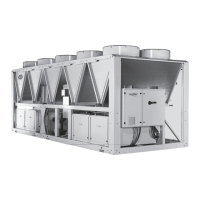24 42GW
• The unit control circuit only allows opening of the motorized valve
when the fan motor is working.
• When the thermostat requests cooling, the V and H outputs supply
the water valve.
WARNING: The pump control circuit stops water supply to the
cold valve if an irregular increase of the condensate water level
is detected into the drain pan
• If an irregular increase of the condensate water level is detected
into the drain pan (for example: possible defective drain, pump
malfunction, fan motor not working) the contact of the “safety level
2” float switch opens to close the regulation valve, stopping the
cold water flow towards the coil and avoiding further condensation.
Control
The water ow has to be controlled:
• Via the assembly of valves supplied as accessories
or
• Via the assembly of valves to be fitted by the installer.
Valve and component assembly (See g. 28).
Mod.42GW
200 500 200 600
300 600 300 701
400 701 400
2-pipe 4-pipe
Ref. Description q.ty q.ty q.ty q.ty
a Servomotor 1 1 2 2
b
Valve 1"gas - 1 - 1
Valve 3/4"gas 1 - 1 1
Valve 1/2"gas - - 1 -
c Shell 1 1 1 1
d Clips 3 3 3 3
e Gasket 2 2 4 4
Instructions for installation of the valve assembly
(see accessories table)
Assembly (Fig. 30)
For 4-tube models, the rst valve assembly is installed on the
cooling circuit rst, followed by the second valve assembly on the
heating circuit.
Fit the actuator motor on the valve body, feed the valve cable into
the casing and connect it to the terminal strip as shown in g. 37.
• If the system is filled with water, check all fitting seals.
• After ending the hydraulic connections, make sure there are no
leaks Insulate the valve using the shell, fix it by means of the clips
and make sure that all cold parts are insulated (fig. 29 – 30).
• For 4-pipe hot water, repeat all the operations with gas adaptors,
as per the table.
Operation of the thermo-electric valve (See g. 31)
• The 2-way valve is normally closed to the coil with no powered
actuator side. The 3-way valve is normally closed to the coil with
no powered actuator side while is open to the bypass way side.
• If an emergency occurs, the valve may be manually opened,
removing the electric head, unscrewing the ring nut.
When the emergency ends, remember to reset the valve to
automatic operation, repositioning the electric head; failure
to do this can result in condensate formation due the water
pipes, even if the unit is switched off.
• On units with a changeover sensor, this must be positioned
on the inlet of the duct on the installation side.
Instructions for eld supplied valves
Water connection
• Install valves following manufacturer's instructions; refer to the
relevant figures for connection to the unit.
• Carefully insulate pipes, valve assemblies and coil connections
(cold water side) to avoid condensation forming on the pipes and
dripping on the false ceiling.
Electrical wiring
• Connect the room control following instructions for the control
used.
ATTENTION: Route the cables through the electrical box as
shown in g. 37.
• Connect the valves according to the instructions and the wiring
diagrams attached to the machine documents.
• Valves, closing the unit water inlet when there is no power
supply, must be used.
230 V ON/OFF type valves on units with electrics box.
• The chilled water valve must be operated by the 230V on-off signal
from terminal V and the hot water valve from terminal H.
• If these connections are not made as described the drain pan
condensate may overflow.
• Valves should open only when the fan is working, that is, when one
of terminals V1, V2, V3 is energized by L mains supply.
• When the system is filled with water, verify all couplings for
tightness.
• The manufacturer does not accept responsibility for the
tightness of the field - installed valve assembly and this is not
tested in the factory.
• It accepts no responsibility for malfunctions on the assemblies
or for damage caused by leaks.
Valve and regulation system

